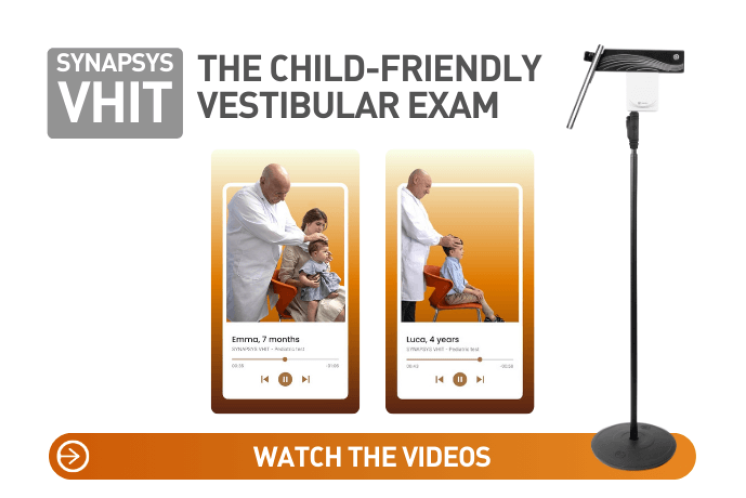New videos on SYNAPSYS VHIT

Video Head Impulse Test in Pediatric Age: Why Early Vestibular Assessment Matters
Vestibular dysfunction is increasingly recognized in children with balance or developmental disorders, with studies reporting prevalence up to 36 % and even higher among those with sensorineural hearing loss. Because children can often compensate and show no overt postural symptoms, mild deficits frequently remain undetected, delaying early neurotological evaluation. Yet vestibular input is fundamental not only for balance and spatial orientation but also for higher cognitive abilities such as spatial navigation, body schema formation, and temporal perception. When impaired during early development, it may hinder motor milestones, self-awareness, and even literacy or numeracy skills.
All children with suspected balance or developmental disorders should undergo a complete ENT and audiological evaluation. Vestibular assessment must be tailored to age and cooperation level, using tools validated for pediatric populations. Thanks to technological advancements, non-invasive methods such as cervical Vestibular Evoked Myogenic Potentials (cVEMPs) and, above all, the remote-camera Video Head Impulse Test (vHIT) now allow accurate evaluation even in very young children.
The SYNAPSYS vHIT of Inventis with remote camera system is particularly well suited for infants and toddlers, as demonstrated in the accompanying clinical videos.
The procedure follows the adult protocol with careful adjustments for the child’s age and ability to cooperate:
- Begin by creating a welcoming environment, using toys, dolls, or other playful items, to help the child relax and build trust.
- Once comfortable, seat the infant or toddler on the lap of a parent or relative, facing the remote camera.
- For children aged 3 months to 3 years, the parent or relative ensures comfort by holding the child securely, while an assistant captures the child’s attention behind the vHIT camera with a toy or video. While the child is focused on this stimulus, the operator delivers the head impulses.
- In children older than 3 years, the procedure can be performed as in adults.
At least five valid impulses per side are required, and some may need to be repeated to account for blinking, loss of attention, or spontaneous movements. A vestibular hypofunction of the lateral or vertical canals is indicated when VOR gain falls below 0.8 or 0.7, respectively.
Discover the Videos
In the two videos presented here, an experienced clinician demonstrates how SYNAPSYS vHIT enables reliable vestibular assessment in pediatric patients, including those as young as three months. These real-life demonstrations provide valuable insights into practical strategies for testing children and highlight the essential role of early vestibular evaluation in supporting healthy motor and cognitive development.
Watch now to learn how early, child-friendly vestibular testing can make a difference:

 Go to the top
Go to the top

 International - English
International - English Italia - Italiano
Italia - Italiano France - Français
France - Français USA - English
USA - English